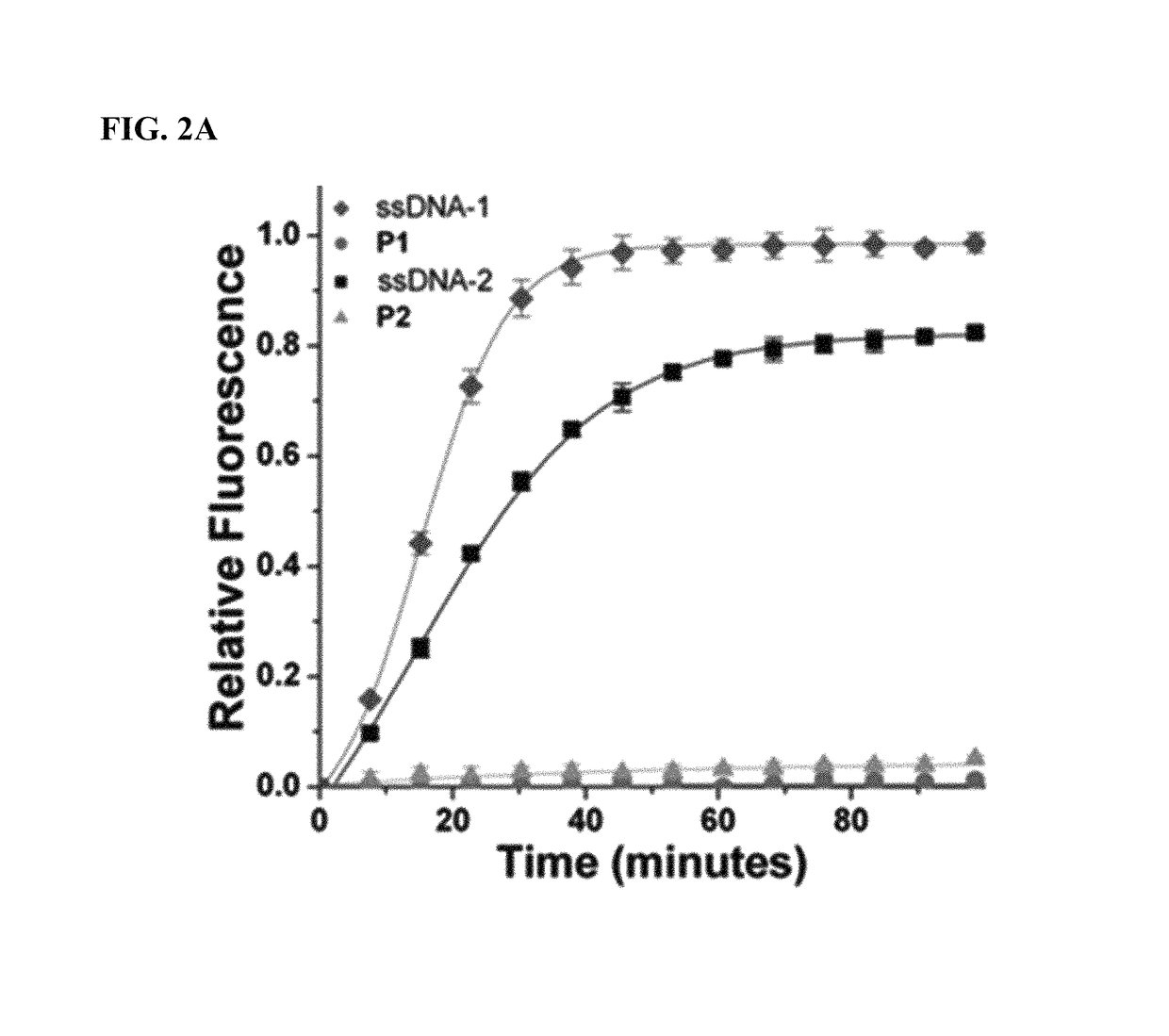Methods for arranging and packing nucleic acids for unusual resistance to nucleases and targeted delivery for gene therapy
a technology of nucleic acids and arranged and packed nucleic acids, which is applied in the direction of biochemistry apparatus and processes, activity regulation, and gene therapy, can solve the problems of limiting the practical utility of nucleic acids modified in detection and as therapeutics in real-world applications, and inherently susceptible to enzymatic degradation
- Summary
- Abstract
- Description
- Claims
- Application Information
AI Technical Summary
Benefits of technology
Problems solved by technology
Method used
Image
Examples
example 1
er Amphiphile Synthesis, Purification and Properties
[0152]General Methods
[0153]Reagents. All reagents were purchased from Sigma-Aldrich and used without further purification. (IMesH2)(C5H5N)2(Cl)2Ru═CHPh was prepared as described by Sanford et. al (Organometallics 2001, 20:5314-5318). DNA synthesis was carried out on an ABI 394 DNA / RNA synthesizer utilizing standard phosphoramidite chemistry. DNA synthesis reagents and custom phosphoramidites were purchased from Glen Research Corporation. CPG support columns and standard phosphoramidites were purchased from Azco Biotech Inc. Nucleases Nt.CviPII and Exonuclease III were purchased from New England Biolabs. Phosphodiesterase I from Crotalus adamanteus was purchased from USB Corporation as a lyophilized powder. All deuterated solvents were purchased from Cambridge Isotope Laboratories Inc. 1H (400 MHz) and 13C (100 MHz) NMR spectra were recorded on a Varian Mercury Plus spectrometer. Chemical shifts (1H) are reported in δ (ppm) relative...
example 2
n Cellular Mechanism of Action
[0190]Nucleic acid, optionally including locked-nucleic acid, (DNA[LNA]) can be conjugated to a synthetic polymer, e.g., that has been synthesized by means of ring-opening metathesis polymerization (ROMP), as known in the art. In aqueous solution, this conjugate can spontaneously form polymeric micelles in an aqueous milieu. The nucleic acid sequences displayed at the exterior of the micelles can then be hybridized to a complementary DNA sequence (e.g., a 12 base sequence) that has been covalently modified with a ligand. In one embodiment, this ligand is (−)-2-β-Carbomethoxy-3-β-(4-fluorophenyl)tropane (β-CFT). The β-CFT ligand binds to the dopamine transporter (DAT), which is specific to a particular neuronal phenotype (the dopamine neuron). Through normal endocytic recycling of the DAT, the resulting complex can be endocytosed. The polymer and nucleic acid can be released into the cytoplasm by destabilizing of the membrane of the endosome through non-...
example 3
Studies
[0200]It has been validated that compositions disclosed herein are not toxic compared with commercially available products, as described following.
[0201]Cell type: Primary human neurons were employed.
[0202]Treatment conditions: 4-hr or 24-hr, at 37° C., 5% CO2. Cell media: serum-free DMEM.
[0203]Reagents:
[0204]R1. Nucleic acid conjugate (SEQ ID NO:8). Underlines indicate LNA residues; “TAM” represents TAMRA:
[0205]
[0206]Incubation Conditions:
[0207]FIG. 15 (entry “Polymer” at far left): 50 pmol R1 plus 50 pmol R3, premixed in 10 mM MgCl2 (100 uL volume) to allow hybridization, then mixed with 400 uL serum free DMEM (500 uL total volume). Time points for all pairs of data in histogram of FIG. 15 are in order (left to right), 4-hr and 24-hr.
[0208]FIG. 15 (entry “Xtreme Gene” second from left): 50 pmol R2 plus 50 pmol R3, mixed in presence of X-tremeGene siRNA Transfection Reagent (Roche). Reagents were diluted with serum free DMEM to a final volume of 500 uL.
[0209]FIG. 15 (entry “...
PUM
| Property | Measurement | Unit |
|---|---|---|
| Tm | aaaaa | aaaaa |
| hydrodynamic diameter | aaaaa | aaaaa |
| concentration | aaaaa | aaaaa |
Abstract
Description
Claims
Application Information
 Login to View More
Login to View More - R&D
- Intellectual Property
- Life Sciences
- Materials
- Tech Scout
- Unparalleled Data Quality
- Higher Quality Content
- 60% Fewer Hallucinations
Browse by: Latest US Patents, China's latest patents, Technical Efficacy Thesaurus, Application Domain, Technology Topic, Popular Technical Reports.
© 2025 PatSnap. All rights reserved.Legal|Privacy policy|Modern Slavery Act Transparency Statement|Sitemap|About US| Contact US: help@patsnap.com



